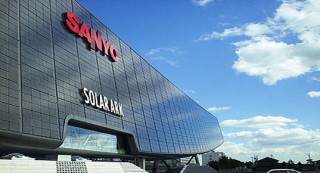Loading
Search
▼ Can Japan Recapture Its Solar Power?
- Category:Other

TECHNOLOGY REVIEW
It’s 38 °C on the Atsumi Peninsula southwest of Tokyo: a deadly heat wave has been gripping much of Japan late this summer. Inside the offices of a newly built power plant operated by the plastics company Mitsui Chemicals, the AC is blasting. Outside, 215,000 solar panels are converting the blistering sunlight into 50 megawatts of electricity for the local grid. Three 118-meter-high wind turbines erected at the site add six megawatts of generation capacity to back up the solar panels during the winter.
Mitsui’s plant is just one of thousands of renewable-power installations under way as Japan confronts its third summer in a row without use of the nuclear reactors that had delivered almost 30 percent of its electricity. In Japan people refer to the earthquake and nuclear disaster at Tokyo Electric Power Company’s Fukushima Daiichi nuclear power plant on March 11, 2011, as “Three-Eleven.” Radioactive contamination forced more than 100,000 people to evacuate and terrified millions more. It also sent a shock wave through Japan’s already fragile manufacturing sector, which is the country’s second-largest employer and accounts for 18 percent of its economy.
Eleven of Japan’s 54 nuclear reactors shut down on the day of the earthquake. One year later every reactor in Japan was out of service; each had to be upgraded to meet heightened safety standards and then get in a queue for inspections. During my visit this summer, Japan was still without nuclear power, and only aggressive energy conservation kept the lights on. Meanwhile, the country was using so much more imported fossil fuel that electricity prices were up by about 20 percent for homes and 30 percent for businesses, according to Japan’s Ministry of Economy, Trade, and Industry (METI).
The post-Fukushima energy crisis, however, has fueled hopes for the country’s renewable-power industry, particularly its solar businesses. As one of his last moves before leaving office in the summer of 2011, Prime Minister Naoto Kan established potentially lucrative feed-in tariffs to stimulate the installation of solar, wind, and other forms of renewable energy. Feed-in tariffs set a premium rate at which utilities must purchase power generated from such sources.
The government incentive is what motivated Mitsui to finally make use of land originally purchased for an automotive plastics factory that was never built because carmakers moved manufacturing operations overseas. The site had sat idle for 21 years before Mitsui assembled a consortium to help finance a $180 million investment in solar panels and wind turbines. By moving fast, Mitsui and its six partners qualified for 2012 feed-in tariffs that promised industrial-scale solar facilities 40 yen (35 cents) per kilowatt-hour generated for 20 years. At that price, says Shin Fukuda, the former nuclear engineer who runs Mitsui’s energy and environment business, the consortium should earn back its investment in 10 years and collect substantial profits from the renewable facility for at least another decade.
Overnight, Japan has become the world’s hottest solar market: in less than two years after Fukushima melted down, the country more than doubled its solar generating capacity. According to METI, developers installed nearly 10 gigawatts of renewable generating capacity through the end of April 2014, including 9.6 gigawatts of photovoltaics. (The nuclear reactors at Fukushima Daiichi had 4.7 gigawatts of capacity; overall, the country has around 290 gigawatts of installed electricity-generating capacity.) Three-quarters of the new solar capacity was in large-scale installations such as Mitsui’s.
Yet this explosion of solar capacity marks a bittersweet triumph for Japan’s solar-panel manufacturers, which had led the design of photovoltaics in the 1980s and launched the global solar industry in the 1990s. Bitter because most of the millions of panels being installed are imports made outside the country. Even some Japanese manufacturers, including early market leader Sharp, have taken to buying panels produced abroad and selling them in Japan.
- December 19, 2014
- Comment (0)
- Trackback(0)

